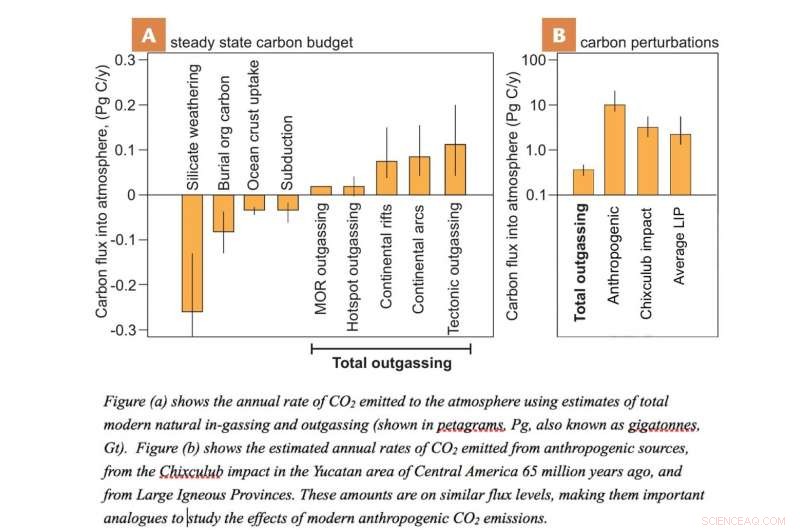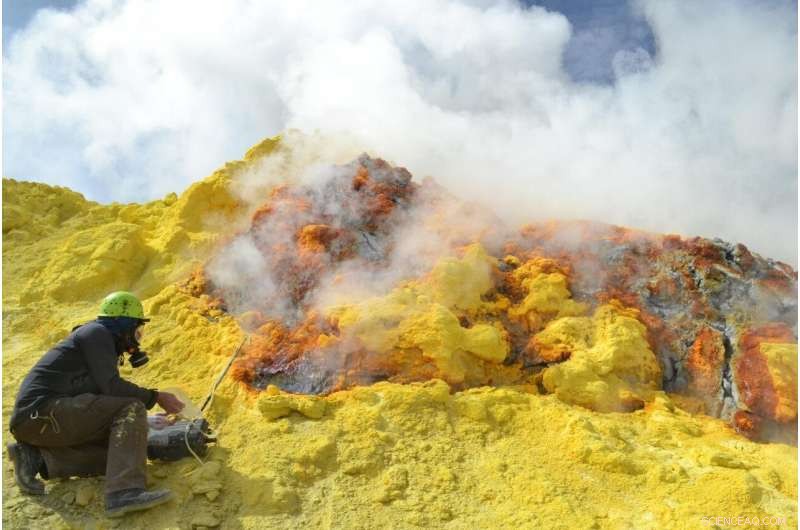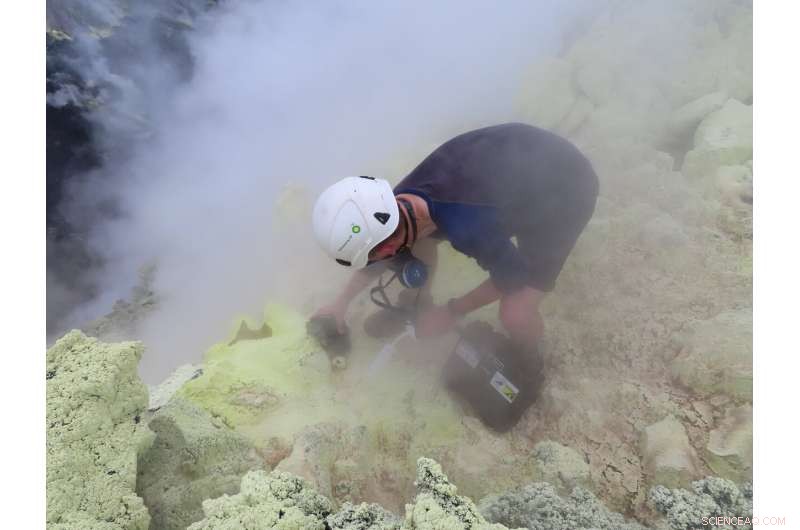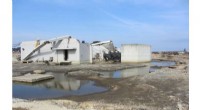
Wetenschap
Wetenschappers kwantificeren de wereldwijde vulkanische CO2-ontluchting; schatting totale koolstof op aarde

Histogrammen van koolstofinstroom (positieve waarden) en uitstroom (negatieve waarden) naar de atmosfeer en de oceanen. Eenheden zijn in Pg C/j. (A) Koolstoffluxen op basis van steady-state-modellen. Afkortingen:MOR =mid ocean ridge; org koolstof =organische koolstof. (B) Koolstoffluxen als gevolg van grootschalige verstoringen van de koolstofcyclus. Totale uitgassing verwijst naar gebeurtenissen die worden vermeld in figuur 2A; antropogeen zijn menselijke bijdragen; Chicxulub (Mexico) verwijst naar de eind-Krijtachtige asteroïde-inslag en de resulterende massa-extinctie; gemiddelde LIP verwijst naar de input van grote vulkanische provincies. Gegevens van Kawaragi et al. (2009), Lee et al. (2019) en Black en Gibson (2019) Krediet:Deep Carbon Observatory
vulkanen, botsingen en verspreiding van continentale en oceanische platen, en andere fenomenen opnieuw bestudeerd met innovatieve hightech tools, belangrijke nieuwe inzichten bieden in de diepste werking van de aarde, wetenschappers zeggen.
Voorbereiding om het 10-jarige Deep Carbon Observatory-programma van de National Academy of Sciences samen te vatten en te vieren, Washington D.C., 24-26 oktober, Het 500-koppige Reservoirs and Fluxes-team van DCO heeft vandaag een aantal belangrijke bevindingen uiteengezet die de tijd overspannen van het heden tot miljarden jaren geleden; van de kern van de aarde naar de atmosfeer, en in grootte van enkele vulkanen tot de vijf continenten.
Onder de vele brede bevindingen, geschetst en samengevat in een reeks artikelen gepubliceerd in het tijdschrift elementen:
- Slechts twee tiende van 1% van de totale koolstof op aarde - ongeveer 43, 500 gigaton (Gt) - is boven het oppervlak in de oceanen, op het land, en in de atmosfeer. De rest is ondergronds, inclusief de korst, mantel en kern - in totaal naar schatting 1,85 miljard Gt
- CO 2 uitgassen naar de atmosfeer en oceanen van vulkanen en andere magmatisch actieve gebieden wordt geschat op 280 tot 360 miljoen ton (0,28 tot 0,36 Gt) per jaar, inclusief die welke vanaf de mid-oceanische ruggen in de oceanen terechtkomen
- De jaarlijkse CO2-uitstoot van de mensheid door de verbranding van fossiele brandstoffen en bossen, enzovoort., zijn 40 tot 100 keer groter dan alle vulkanische emissies
- De diepe koolstofcyclus van de aarde door diepe tijd onthult evenwichtige, stabiliteit op lange termijn van atmosferisch CO 2 , onderbroken door grote storingen, waaronder enorm, catastrofale lozingen van magma die in de afgelopen 500 miljoen jaar minstens vijf keer hebben plaatsgevonden. Tijdens deze evenementen, enorme hoeveelheden koolstof ontgassen, wat leidt tot een warmere atmosfeer, verzuurde oceanen. en massale uitstervingen
- evenzo, een gigantische meteoorinslag 66 miljoen jaar geleden, de aanval van Chicxulub bolide op het schiereiland Yucatan in Mexico, uitgebracht tussen 425 en 1, 400 Gt CO 2 , warmde de planeet snel op en viel samen met de massa (> 75%) uitsterven van planten en dieren, inclusief de dinosauriërs. In de afgelopen 100 jaar, emissies van antropogene activiteiten zoals het verbranden van fossiele brandstoffen zijn 40 tot 100 keer groter dan de geologische koolstofemissies van onze planeet
- Een verschuiving in de samenstelling van vulkanische gassen van stinkende (vergelijkbaar met verbrande lucifers) zwaveldioxide (SO2) naar een gas rijker aan geurloze, kleurloze CO 2 kan worden opgesnoven door meetstations of drones om te waarschuwen voor een uitbarsting - soms uren, soms maanden van tevoren. Vroegtijdige waarschuwingssystemen voor uitbarstingen met realtime monitoring gaan vooruit om de CO . te benutten 2 tot SO2-verhouding ontdekking, voor het eerst met zekerheid erkend in 2014
Zegt DCO-wetenschapper Marie Edmonds van de Universiteit van Cambridge, VK:"Koolstof, de basis van al het leven en de energiebron die van vitaal belang is voor de mensheid, beweegt door deze planeet van zijn mantel naar de atmosfeer. Om een duurzame toekomst veilig te stellen, het is van het grootste belang dat we de hele koolstofcyclus van de aarde begrijpen."
"De sleutel tot het ontrafelen van de natuurlijke koolstofcyclus van de planeet is het kwantificeren van hoeveel koolstof er is en waar, hoeveel beweegt - de flux - en hoe snel, van Deep Earth-reservoirs naar de oppervlakte en weer terug."
voegt collega Tobias Fischer van de Universiteit van New Mexico toe, VS:"The Deep Carbon Observatory heeft een beter begrip gekregen van de innerlijke werking van de aarde. Het collectieve lichaam van meer dan 1500 publicaties heeft niet alleen het bekende vergroot, maar ook grenzen gesteld aan wat bekend is, en misschien onkenbaar."
"Terwijl we de vooruitgang vieren, we onderstrepen dat de diepe aarde een zeer onvoorspelbare wetenschappelijke grens blijft; we zijn echt pas begonnen met het deuken van de huidige grenzen van onze kennis."
Hoeveel koolstof bevat de aarde?
Wetenschappers weten al lang dat koolstof in de aarde bestaat als een gevarieerde reeks vaste stoffen, vloeistoffen, en gassen. Sommige van deze materialen bevatten combinaties van koolstof met zuurstof (bijvoorbeeld koolstofdioxide), met ijzer (bijv. carbiden), met waterstof (bijv. kerogeen, steenkool, aardolie, en methaan), en andere elementen (bijv. silicium, zwavel, en stikstof), naast elementaire koolstof (bijv. grafiet en diamant).
Wetenschappers van Deep Carbon Observatory onderstrepen dat de kennis van de totale koolstof in de lagere mantel en de kern nog steeds speculatief is en dat de cijfers zeker zullen evolueren in nauwkeurigheid naarmate het onderzoek vordert. Dat gezegd hebbende, experts (met name Lee et al ., 2019) schat de koolstofreservoirs op aarde als volgt:
Volgens de cijfers:beste huidige schattingen, koolstof op aarde
1,85 miljard gigaton (1,85 x 1 miljard x 1 miljard ton):totale koolstof op aarde

Gasbemonstering bij de vulkaan Lastarria (Noord-Chili) tijdens de Trail by Fire-expeditie (trailbyfire.org) Credit:Yves Moussallam, Lamont Doherty Earth Observatory
Afbreken:
- 1, 845, 000, 000 (1,845 miljard) Gt:totale koolstof onder het oppervlak
- 1, 500, 000, 000 (1,5 miljard) Gt:Koolstof in de onderste mantel:
- 315, 000, 000 (0,315 miljard) Gt:koolstof in de continentale en oceanische lithosfeer
- 30, 000, 000 (0.03 billion) Gt:Carbon in the upper mantle
- 43, 500 Gt:total carbon above surface—in the oceans, op het land, and in the atmosphere (2/10ths of 1% of Earth's total carbon)
- 37, 000 Gt:Carbon in the deep ocean (85.1% of all above surface carbon)
- 3, 000 Gt:Carbon in marine sediments (6.9%)
- 2, 000 Gt:Carbon in the terrestrial biosphere (4.6%)
- 900 Gt Carbon in the surface ocean (2%)
- 590 Gt:Carbon in the atmosphere (1.4%)
vrijkomen van CO 2 van vulkanen
Earth's total annual out-gassing of CO 2 via volcanoes and through other geological processes such as the heating of limestone in mountain belts is newly estimated by DCO experts at roughly 300 to 400 million metric tonnes (0.3 to 0.4 Gt).
Volcanoes and volcanic regions alone outgas an estimated 280-360 million tonnes (0.28 to 0.36 Gt) of CO 2 per year. This includes the CO 2 contribution from active volcanic vents, from the diffuse, widespread release of CO 2 through soils, faults, and fractures in volcanic regions, volcanic lakes, and from the mid-ocean ridge system.
In many world regions, tectonic outgassing (emissions from mountain belts and other plate boundaries), particularly in cool night temperatures, can cause dangerous levels of CO 2 close to the ground—enough to suffocate livestock.
According to DCO researchers, with rare exceptions over millions of years the quantity of carbon released from Earth's mantle has been in relative balance with the quantity returned through the downward subduction of tectonic plates and other processes.
Carbon catastrophes
While the volume of carbon buried through subduction and what's released from volcanoes and tectonic fractures are normally in steady state, about four times over the past 500 million years this balance has been upended by the emergence of large volcanic events—1 million or more square kilometers (the area of Canada) of magma released within a timeframe of a few tens of thousands of years up to 1 million years.
These "large igneous provinces" degassed enormous volumes of carbon (estimated at up to 30, 000 Gt—equal to about 70% of the estimated 43, 500 Gt of carbon above surface today).
Carbon cycle imbalance can cause rapid global warming, changes to the silicate weathering rate, changes to the hydrologic cycle, and overall rapid habitat changes that can cause mass extinction as the Earth rebalances itself.
Similar carbon catastrophes have been caused by asteroids / meteors (bolides), such as the massive Chixculub impact in the Yucatan area of Central America 65 million years ago—an event to which extinction of the dinosaurs and most other plants and animals of the time has been attributed.

Year-round monitoring at five volcanoes revealed that the level of carbon dioxide relative to sulfur dioxide in volcanic gases systematically changes in the hours to months before an eruption. Here Deep Carbon Observatory volcanologist Brendan McCormick installs a DECADE (Deep Earth Carbon DEgassing) subgroup MultiGAS monitoring device at Rabaul Volcano, Papoea-Nieuw-Guinea. Credit:Emma Liu, University of Cambridge
According to Australian researchers Balz Kamber and Joseph Petrus:"The Chicxulub event ... greatly disrupted the budget of climate-active gases in the atmosphere, leading to short-term abrupt cooling and medium-term strong warming."
"Dus, some large bolide impacts are comparable to those observed in the Anthropocene in terms of rapidly disrupting the C (carbon) cycle and potentially exceeding a critical size of perturbation."
Wiring up volcanoes
DCO experts estimate that about 400 of the 1500 volcanoes active since the last Ice Age 11, 700 years ago are venting CO 2 today. Another 670 could be producing diffuse emissions, with 102 already documented. Of these, 22 ancient volcanoes that have not erupted since Pleistocene epoch (2.5 million years ago to the Ice Age) are outgassing. Thus all volcanoes, the young and very old, may be emitting CO 2 .
Today's CO 2 , sulphur dioxide and hydrogen sulphide emissions rates are now quantified for many of the world's most active volcanoes thanks in part to the development of miniature, duurzaam, inexpensive instruments.
And several volcanoes have been wired up with permanent gas instrument monitoring stations to obtain real time data readings, improving monitoring by governments and universities in the U.S., Italië, Costa Rica, and elsewhere. About 30 collaboratively operated gas-monitoring stations on volcanoes across five continents now exist, which continually monitor emissions.
Pioneered by scientists with DCO's DECADE (Deep Earth Carbon DEgassing) subgroup, the technologies and installations have helped revolutionize data collection within inaccessible or dangerous volcanic places. The data obtained are combined with readings from long-established ground and satellite systems.
Recent research has revealed the number of volcanoes thought to be out-gassing measurable amounts of CO 2 today. Estimated at 150 in 2013, DECADE researchers confirm that more than 200 volcanic systems emitted measurable volumes of CO 2 between the years 2005 and 2017. Of these, several super-regions of diffuse degassing have been documented (e.g., Yellowstone, ONS., the East African Rift, Afrika, and the Technong volcanic province in China, to name a few). Diffuse degassing is now recognized as a CO 2 source comparable to active volcanic vents.
Among the DCO's legacies:a new database (http://www.magadb.net) to capture information on CO 2 fluxes from volcanic and non-volcanic sources around the world.
Volcanic whispers:Changes in ratio of vented SO2 to CO 2 can forewarn of eruptions
Research at a growing number of well-monitored volcanoes worldwide has provided important new insight about the timing of eruptions relative to the composition of volcanic outgassing.
Year-round monitoring at five volcanoes revealed that the level of carbon dioxide relative to sulfur dioxide in volcanic gases systematically changes in the hours to months before an eruption. Volcanoes where such patterns have been documented include Poas (Costa Rica), Etna and Stromboli (Italy), Villarica (Chile), and Masaya (Nicaragua).
Likewise the CO 2 to SO2 ratio changed dramatically months to years prior to large eruptions at Kilauea (Hawaii) and Redoubt Volcano (Alaska), in the U.S., suggesting that monitoring gas composition, often in invisible plumes, offers a new eruption forecasting tool that, in sommige gevallen, precedes increases in volcano seismicity or ground deformation.
 Nieuw superomnifoob glas zweeft hoog op vlindervleugels met behulp van machine learning
Nieuw superomnifoob glas zweeft hoog op vlindervleugels met behulp van machine learning Onderzoekers ontwikkelen levensvatbare, milieuvriendelijk alternatief voor piepschuim
Onderzoekers ontwikkelen levensvatbare, milieuvriendelijk alternatief voor piepschuim Hoe maak je een eierschaal los voor een Science Fair Project
Hoe maak je een eierschaal los voor een Science Fair Project  Een zelfherstellend composiet
Een zelfherstellend composiet Nieuwe techniek bouwt superharde metalen uit nanodeeltjes
Nieuwe techniek bouwt superharde metalen uit nanodeeltjes
Hoofdlijnen
- Sarcodina Life Cycle
- Wat gebeurt er met plantaardige en dierlijke cellen wanneer ze worden geplaatst in hypertone, hypotone en isotone omgevingen?
- Secretine-eiwit met een kroon
- Vitamine E-ontdekking in maïs kan leiden tot meer voedzame gewassen
- Ideeën voor wetenschapsbeurzen Projecten met honden
- Het vreemde geval van de duikvlieg
- Zoektocht naar nieuwe medicijnen kan worden geholpen door celontdekking
- Nieuwe filmtechniek onthult bacteriële signalering in scherpere resolutie
- Hoe kunnen botten bloedcellen aanmaken?
- Maritieme robots kunnen de voorspellingen van het Europese weer in de toekomst verbeteren

- Voorbeelden van biogeografisch bewijs voor evolutie

- Onderzeese topografie genereert hotspots van oceaanmenging

- Wat is een loopscore?

- Onderzoekers ontwikkelen verbeterde methode voor het bestuderen van tsunami-risico's voor bruggen, gebouwen, wegen

 Watermoleculen gebruiken om neuronengeheimen te ontsluiten
Watermoleculen gebruiken om neuronengeheimen te ontsluiten Onderzoekers vinden nieuwe manier om de kleur en textuur van vlindervleugels na te bootsen
Onderzoekers vinden nieuwe manier om de kleur en textuur van vlindervleugels na te bootsen Het vloeistofvolume berekenen
Het vloeistofvolume berekenen  Vernietiging van een fragment van een Atlantisch regenwoud verhoogt de lokale temperatuur
Vernietiging van een fragment van een Atlantisch regenwoud verhoogt de lokale temperatuur Beeldgestuurde borstkankertherapie mogelijk gemaakt door nanodrug
Beeldgestuurde borstkankertherapie mogelijk gemaakt door nanodrug Dictionary.com kiest medeplichtige als woord van het jaar
Dictionary.com kiest medeplichtige als woord van het jaar Klimaatverandering zorgt ervoor dat de Zwitserse Alpen meer dan 1 toevoegen 000 meren:studie
Klimaatverandering zorgt ervoor dat de Zwitserse Alpen meer dan 1 toevoegen 000 meren:studie Nikkelkatalysator vergemakkelijkt de creatie van een enkele stereo-isomeer met twee chirale centra
Nikkelkatalysator vergemakkelijkt de creatie van een enkele stereo-isomeer met twee chirale centra
- Elektronica
- Biologie
- Zonsverduistering
- Wiskunde
- French | Italian | Spanish | Portuguese | Swedish | German | Dutch | Danish | Norway |

-
Wetenschap © https://nl.scienceaq.com

